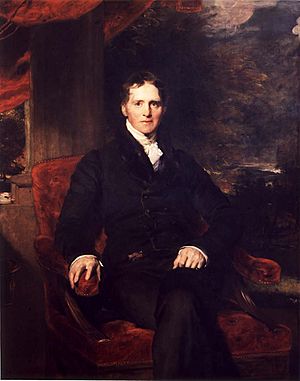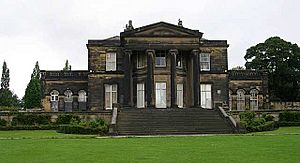Benjamin Gott facts for kids
Benjamin Gott (born June 24, 1762 – died February 14, 1840) was a very important person during the industrial revolution. He was a leader in making textiles, which are fabrics like wool. His factory in Armley Mills, Armley, Leeds, was once the biggest factory for wool in the whole world! Today, this famous factory is the Leeds Industrial Museum at Armley Mills.
Contents
Early Life and Learning
Benjamin Gott was born in a place called Calverley, near Pudsey in West Yorkshire, England. His father, John Gott, was a civil engineer who designed and built things. Benjamin went to Bingley Grammar School until he was 17 years old.
After school in 1780, Benjamin started working as an apprentice. This means he learned a trade from experienced people. He worked for Wormald & Fountaine, who were merchants selling wool. Later, his own sons, John and William Gott, joined his company, Gott & Sons, and took over running it around 1825.
Building a Textile Empire
Benjamin Gott's biggest achievement was at Armley Mills. He leased this mill in 1804. The mill had been badly damaged by a fire. When he bought the burned-out building, he made sure it was rebuilt with special features. He used cast iron frames inside and other ways to make it fire-safe.
When the repairs were finished in 1805, the new Armley Mills factory became the largest wool factory anywhere. Gott was always trying new ways to make wool cloth. He was one of the first to use steam power and power looms, which were machines that made weaving much faster.
Benjamin Gott became very rich from his work. He used a lot of his money to make his mills even better and to buy new ones. He also helped his community. He built almshouses in Armley, which were homes for poor people. He also collected beautiful art. In 1819, he helped start the Leeds Philosophical & Literary Society, a group that discussed new ideas and discoveries.
Besides Armley Mills, he owned other important factories. These included Bean Ings, which opened in 1792 and was his first wool factory. He also had Burley Mills (1798) and St Ann's Mills (1824).
Public Life and Legacy
Benjamin Gott was a respected person in his city. He became the Mayor of Leeds in 1799. By the time he passed away in 1840, he was a millionaire.
His home from 1812 was Armley House, which is now called Gotts Park Mansion. The famous landscape designer Humphrey Repton designed its beautiful gardens. From his home, Gott could look out over the Kirkstall Valley and the Leeds and Liverpool Canal. In 1928, Leeds City Council leased Gott's house and grounds. They turned it into a public golf course and Armley Park for everyone to enjoy.
Benjamin Gott died on February 14, 1840. He is buried in the Armley Parish church. His son, Joseph Gott, who was a sculptor, created the tomb with a statue of his father.
Family Connections
Benjamin Gott had several children who also became notable.
- His son Joseph Gott became a famous sculptor.
- Another son, William Gott, was known for his charity work.
Benjamin Gott was also the grandfather of Bishop John Gott.
His great-granddaughter was Beryl Katherine Gott. She married her cousin, Frank Gott. Frank Gott was the Lord Mayor of Leeds from 1917 to 1918. Beryl was the Lady Mayoress. She also made history by becoming Leeds's first woman alderman and one of the first four women judges appointed to the Leeds Bench.



